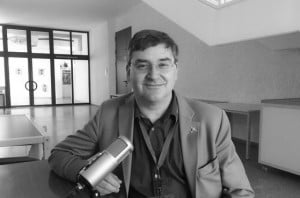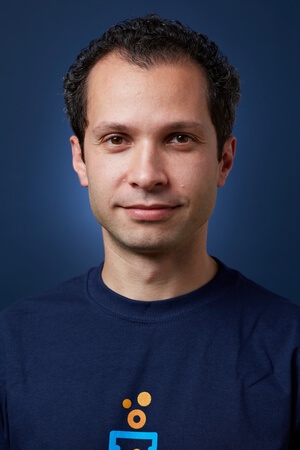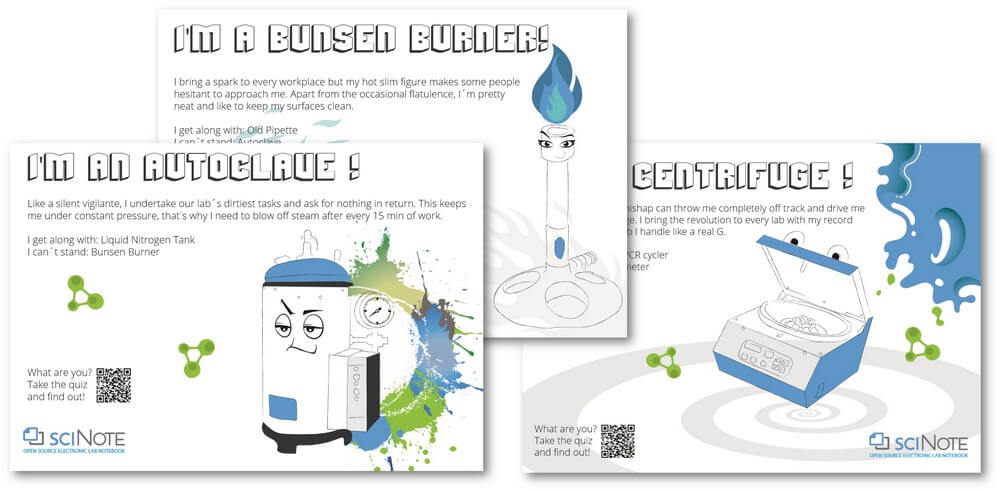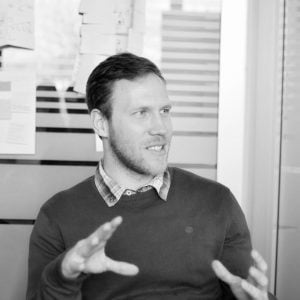Meet Michael Rhodes, Nanostring.
It’s a really interesting job. But if you would have told me when I was doing my PhD, that I was going to end up moving to America and living in America, getting to travel around the world and meeting all off these leading scientists I wouldn’t believe it.
MUKUNDH: Hello! We are here today with Michael Rhodes, at the qPCR and NGS Event in Freising, Germany. He is the Director of Collaborations and Application Development at NanoString. He’s had quite an interesting journey in the world of genomics over the past few decades. He is going to share with us today his experience from his long and exciting journey. Michael, let’s get started with your first fascination with science and research.
MICHAEL: So, my father is a pharmacist and my mother was a qualified pharmacist as well, so I come from a scientific family. Since I was a small boy up to when I went to University I was going to be a marine biologist. My father did something that I think more fathers should do, he arranged for me to meet an actual marine biologist beforehand and he recommended that I do a general biology degree and proceed to marine biology during the PhD. I agreed and went to York University. This was mainly because among the Universities I visited, that was the one I thought I could live in for three years, which is probably not the most rational reason for choosing the university. There, during the biology course, you could specialize after the first five terms. By the end of those five terms, I became very enamored with genetics. This was in the days when people were saying that molecular biology should maybe become a course in itself.
The two things I can remember from my lecturers is one of my lecturers walking in and saying “Genetics is the biology of sex” and the other one saying “In the future you’ll just buy your reagents, you’ll add them together and they’ll change color to show you made the right thing.
I took the degree in genetics at the York University and went to Birkbeck College which is part of University of London to do my PhD. There I worked on genetics, mainly kinetics and proteins of methyl transport. During the course I worked with radioactive gold. The compound we were working on was gold phosphate. At the time it was very difficult in England to get radioactive gold, so I did a month in Chicago, USA. When I finished my PhD I actually went back to that lab and did a post doc there for two and a half years. Then I decided to go back to England and got a job at the MRC, the UK Human Genome Mapping Project Resource Centre. The aim of the project was to provide resources for labs, so we would provide things like filter sets. We spotted a whole bunch of clogs in the filters and we provided lots of services. One of the things we provided that really appealed was the “Linkage Hotels”. This was in the olden days when microsatellites were still king (for linkage that is), so we provided the equipment, the computing power and the expertise. Then research scientists in the UK could apply, come to the “Hotel” and they just brought their samples and had rapid access to everything.
This is when I became very enamored with genotyping. I worked in this unit for six years and then it became clear to me that the unit was changing and the direction was changing. I assumed this unit was going to close down and I was correct, but I was just seven years too early. I was looking for jobs and back then the internet was not as powerful as it is now. I saw an ad for a job at Applied Biosystems (ABI) and sent my CV. I got a phone call from Applied Biosystems asking me if I really wanted to work for them. I said yes and the response was that this job was way too junior for me and they could get me something else. This was around 2000, during the big boom in the biotech industry, they were looking for talent and they created a job when they found talented people. So I moved over to the US with my wife and we’ve been there for fourteen years and are now joint citizens. My joke is that I can have healthcare and a gun! I worked with ABI for years, starting out with genotyping and capillary systems and helped to set up their applications team for TaqMan Assays on demand. Then all this talk about Next Generation Sequencing started to come out and I was not the only one, Many people in Life Technologies... In the meantime Applied BioSystems became a part of Life Technologies and now they are Thermo Fisher...
MUKUNDH: Yes, I know what you mean, the first time I heard of NGS, well one of my first inspirations go into molecular biology was the movie GATTACA.
MICHAEL: Yes, it is a great movie. I am a firm believer that they were very clever in that film. I mean they didn’t try to explain how it worked. So I wanted to work on the NGS. Life Technologies started off with the SOLiD™ platform, which was actually the most accurate platform at the time. One thing I really learned while working with SOLiD™ was when you are thinking about what customers want there is a point at which it is good enough. People will tell you that they want 100% accuracy but after you ask them if they want to pay for it, then they would say that 99, 5 % is good enough. So we learned an awful lot then.
That is one of the big advantages of a science career: there are options even if you decide that pure academia is not for you and you really want to contribute. Last century was the century of physics but this century is the century of biology. My big contribution was joining an industrial company.
Since then Applied Biosystems was bought by Life Technologies, I got involved in that team. It was a big company, things were changing and I needed to look around. One of my ex colleagues at Life Technologies moved to NanoString. I sent him my congratulations and he asked whether I would like to do for NanoString what I was doing for Life Technologies. I said yes, but I didn’t want to move to Seattle. So he replied that I was going to need to travel a lot, 30 - 40 weeks travelling a year, so I didn’t need to be in Seattle, which was good.
I took the job and I have been with NanoString for two and a half years. I travel an awful lot. I usually do around 250 thousand miles (over 400 thousand kilometers) in planes a year. I live in San Francisco and mostly I travel to Asia or Europe. It’s a really interesting job. But if you would have told me when I was doing my PhD, that I was going to end up moving to America and living in America, getting to travel around the world and meeting all off these leading scientists I wouldn’t believe it. It’s been absolutely incredible. That is one of the big advantages of a science career: there are options even if you decide that pure academia is not for you and you really want to contribute. Last century was the century of physics but this century is the century of biology. My big contribution was joining an industrial company.
I speak with a lot of doctors and what they want tests where they've completed the test and it gives them the answer. People often refer to this as the traffic-light-test. The doctors want it to say red, green. And if it’s green to tell them: “Ok, this patient needs twice as much drug as the other patient”.
MUKUNDH: Thank you for sharing that Michael. One of the things from your talk earlier today was that NGS is more of a discovery tool. Could you talk to us a little bit more about this?
MICHAEL: With NGS... Making the libraries is still challenging, as is doing the analysis. Even though there are many automated pipelines it is still challenging. There is so much to discover.
NGS is ideally suited for discovery.
One of the big debates is what you do when you are doing something like a whole exome screen, can you find some mutations that are relevant for the disease and you find other mutations as well. There was the big discussion on the non-invasive fetal testing. There was an example where they did a test and not the child but the actual mother-to-be supposedly had cancer. The trouble was that it was a non-validated thing, so do you say that there is a potential and that a person should go and do other tests? These other tests are a lot of stress and it might turn out that it was a fake result. I don’t think we’re ready for many of these things.
Where NGS is suitable is whole exome sequencing and there has been a lot of success, especially with individuals, often young people who have got some metabolic disorder or something similar and who were not able to get a diagnosis for ten or fifteen years. NGS, experts look at it and they are able to say there are some mutated genes. You still need to go back and test that with approved testing methods but it gets you closer to the answer. But I don’t think we are completely ready for that yet. I speak with a lot of doctors and what they want tests where they’ve completed the test and it gives them the answer. People often refer to this as the traffic-light-test. The doctors want it to say red, green. And if it’s green to tell them: “Ok, this patient needs twice as much drug as the other patient”. More targeted and precise things, like NanoString, allow that. This was one of the things that made me move to NanoString.
When you move from R&D to a more clinical-type environment, with clinicians and pathology people, there’s an interest in clinical action. The fact it’s really fascinating biology doesn’t bother them. What they need in their work is something that is clinically actionable and can make a difference for a patient.
While discussing the diagnostic value we are developing they were very professional about it. Living in Silicon Valley you meet a lot of equipment companies who are trying to make a machine, they don’t quite get there and then they become a diagnostics company. At NanoString they were very keen to try and improve the work that has been done in the area of gene expression signatures. There’s one database that’s not been maintained for maybe three years that has around 3000 gene signatures in it. There are lots of gene signatures out there. We travel to a lot of pathology departments. They have lots of signatures that have clinically actionable effects that they want to implement.
That is the key thing in this field. When you move from R&D to a more clinical-type environment, with clinicians and pathology people, there’s an interest in clinical action. The fact it’s really fascinating biology doesn’t bother them. What they need in their work is something that is clinically actionable and can make a difference for a patient. That’s what we hope to bring both with the FDA approved tests we do and the enabling of people to develop their own tests, which I think is going to be a big thing among different small pathology departments.
I was talking to one doctor and he said that the scariest thing you can see as a doctor is at 3 am in an emergency room when someone approaches you with a vast pile of print outs from the internet.
MUKUNDH: One thing that was interesting about your view on testing and clinical applications of new technologies was the chasm that exists between technology and researchers and dealing with patients and the patients themselves. Here, ethics has a big role.
MICHAEL: I think there is a huge societal factor here. For the moment, one of the things we are seeing, especially in America, is conflict between patients and doctors. This is as more and more information becomes available for the patients who obviously have a very direct, personal involvement. I was talking to one doctor and he said that the scariest thing you can see as a doctor is at 3 am in an emergency room when someone approaches you with a vast pile of print outs from the internet. There are some people who are very knowledgeable about their disease and often know huge amounts about it and are able to go and get some things done and are able to get their own genome sequenced and this sometimes produces more and more conflict.
I always say to people, who say you shouldn’t get your genome sequenced because you might misinterpret it and make bad decisions that I think one of the things we do now is ensure that people weigh themselves and calculate their body mass index, and unfortunately some people overreact to that. It is well known that not just young teenage girls (that’s the example we’ve all heard of) look at their body mass indexes, as in some cases they are completely incorrect, but we don’t suggest that people don’t weigh themselves.
Maybe everyone’s child is going to be sequenced. Coming from America, I think the drive for that is not going to necessarily be a clinical thing; it’s going to be the cost. And then who owns that data?
I think it is a really big question on how can we cope with this fact, as it is incredibly complicated. Even the best experts are experts in particular areas of physiology. So how do we go about doing this? Maybe everyone’s child is going to be sequenced. Coming from America, I think the drive for that is not going to necessarily be a clinical thing; it’s going to be the cost. In California I believe at the moment something like 50 tests are done, but if it’s cheaper to do an entire genome than doing those 50 tests, it’ll get done. And then who owns that data? If you have a child and you have the genome data, does the parent have it and what do they do with it? What if they lose it? What if they make decisions about the child based on that? I am a big believer that we are going to see a new field of consumer genomics. Actually, we already have it; it is very small at the moment, but if you actually look at the genealogy researchers, they are all using it. And they are all really keen for the next new batch of data. There are all sorts of other things.
I worked in my youth with a twin studies person and he was very interested in learning difficulties. Imagine of your child is tested when they are young, and we are going to take children and throw them in the trash because we realize they’ve got a bias towards picking up some learning difficulties. What if certain types of genotypes will benefit from certain teaching methods? I used to teach. I used to volunteer and teach dyslexics. It was very interesting. It was nearly always the same story. They had a period at school when they missed school, they moved around and when they went back to school they were lagging. Unfortunately not all teachers are the same and they dismissed them as being stupid and just stopped. Once we got them interested and motivated in reading again, they picked it up. Imagine these sorts of things.
In the US I think the market for hair products being bought is around $3 billion a year. There is a lot of science going on. Imagine if you had your whole genome screened when you were a child and you were able to say when you are 25 you’ll have a type of baldness. It is certainly not a health thing but when you see what people will do to keep their hair...
It is all about collaboration. You should assume that you are going to work in multiple labs and, it is possible, in multiple countries, so build up that network. Collaboration is key for today’s science.
MUKUNDH: Yes, that is really fascinating. So Michael before we let you go today, do you have any pearls of wisdom for researchers, PhD students, post docs, early career scientists…?
MICHAEL: When I was doing my PhD the British Government ran a course where they sent us away for a week to teach. There were jobs outside the academia but I don’t think that’s needed anymore; everyone realizes that. My big advice to anyone would be to do the subjects you enjoy. That is the number one thing, especially if you are a graduate. If you are now going to apply for a PhD, do a PhD on something that interests you. If you are on the first, second, third year of your degree and there are some parts that absolutely fascinate you, don’t be afraid to write to that lab and saying this fascinates you and you are thinking of doing a PhD. What I’ve seen is that all people who are really successful in academia are successful for two reasons. The first is that they are doing something they love and the second is that they collaborate. It is all about collaboration. You should assume that you are going to work in multiple labs and, it is possible, in multiple countries, so build up that network. Collaboration is key for today’s science.
MUKUNDH: Thanks for the fascinating conversation Michael!
MICHAEL: Thank you!
[tw_callout size="waves-shortcode" text="" callout_style="style2" thumb="" btn_text="Republish the article" color="#37a0d9" btn_url="https://scinote.net/blog/republish/" btn_target="_blank"]





